
The Sombrero Galaxy is a peculiar galaxy of unclear classification in the constellation borders of Virgo and Corvus, being about 9.55 megaparsecs from the Milky Way galaxy. It is a member of the Virgo II Groups, a series of galaxies and galaxy clusters strung out from the southern edge of the Virgo Supercluster. It has an isophotal diameter of approximately 29.09 to 32.32 kiloparsecs, making it slightly bigger in size than the Milky Way.

Messier 77 (M77), also known as NGC 1068 or the Squid Galaxy, is a barred spiral galaxy in the constellation Cetus. It is about 47 million light-years (14 Mpc) away from Earth, and was discovered by Pierre Méchain in 1780, who originally described it as a nebula. Méchain then communicated his discovery to Charles Messier, who subsequently listed the object in his catalog. Both Messier and William Herschel described this galaxy as a star cluster. Today, however, the object is known to be a galaxy. It is one of the brightest Seyfert galaxies visible from Earth and has a D25 isophotal diameter of about 27.70 kiloparsecs (90,000 light-years).
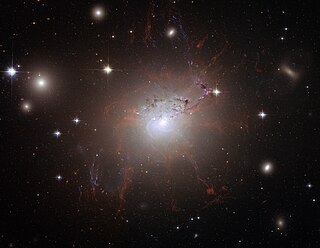
NGC 1275 is a type 1.5 Seyfert galaxy located around 237 million light-years away in the direction of the constellation Perseus. NGC 1275 is a member of the large Perseus Cluster of galaxies.

NGC 520 is a pair of colliding spiral galaxies about 105 million light-years away in the constellation Pisces. They were discovered by astronomer William Herschel on 13 December 1784.

The Eyes Galaxies are a pair of galaxies about 52 million light-years away in the constellation Virgo. The pair are members of the string of galaxies known as Markarian's Chain.

NGC 5033 is an inclined spiral galaxy located in the constellation Canes Venatici. Distance estimates vary from between 38 and 60 million light years from the Milky Way. The galaxy has a very bright nucleus and a relatively faint disk. Significant warping is visible in the southern half of the disk. The galaxy's relatively large angular size and relatively high surface brightness make it an object that can be viewed and imaged by amateur astronomers. The galaxy's location relatively near Earth and its active galactic nucleus make it a commonly studied object for professional astronomers.

NGC 5005, also known as Caldwell 29, is an inclined spiral galaxy in the constellation Canes Venatici. The galaxy has a relatively bright nucleus and a bright disk that contains multiple dust lanes. The galaxy's high surface brightness makes it an object that is visible to amateur astronomers using large amateur telescopes.

A low-ionization nuclear emission-line region (LINER) is a type of galactic nucleus that is defined by its spectral line emission. The spectra typically include line emission from weakly ionized or neutral atoms, such as O, O+, N+, and S+. Conversely, the spectral line emission from strongly ionized atoms, such as O++, Ne++, and He+, is relatively weak. The class of galactic nuclei was first identified by Timothy Heckman in the third of a series of papers on the spectra of galactic nuclei that were published in 1980.

NGC 1614 is the New General Catalogue identifier for a spiral galaxy in the equatorial constellation of Eridanus. It was discovered on December 29, 1885 by American astronomer Lewis Swift, who described it in a shorthand notation as: pretty faint, small, round, a little brighter middle. The nebula was then catalogued by Danish-Irish astronomer J. L. E. Drayer in 1888. When direct photography became available, it was noted that this galaxy displayed some conspicuous peculiarities. American astronomer Halton Arp included it in his 1966 Atlas of Peculiar Galaxies. In 1971, Swiss astronomer Fritz Zwicky described it as a "blue post-eruptive galaxy, compact patchy core, spiral plumes, long blue jet SSW".
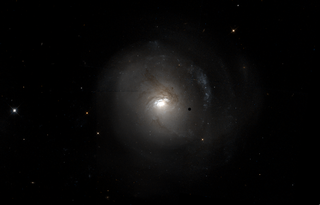
NGC 2782 is a peculiar spiral galaxy that formed after a galaxy merger in the constellation Lynx. The galaxy lies 75 million light years away from Earth, which means, given its apparent dimensions, that NGC 2782 is approximately 100,000 light years across. NGC 2782 has an active galactic nucleus and it is a starburst and a type 1 Seyfert galaxy. NGC 2782 is mentioned in the Atlas of Peculiar Galaxies in the category galaxies with adjacent loops.

NGC 3256 is a peculiar galaxy formed from the collision of two separate galaxies in the constellation of Vela. NGC 3256 is located about 100 million light-years away and belongs to the Hydra–Centaurus Supercluster complex. NGC 3256 provides a nearby template for studying the properties of young star clusters in tidal tails. The system hides a double nucleus and a tangle of dust lanes in the central region. The telltale signs of the collision are two extended luminous tails swirling out from the galaxy. The tails are studded with a particularly high density of star clusters. NGC 3256 is the most luminous galaxy in the infrared spectrum located within z 0.01 from Earth.
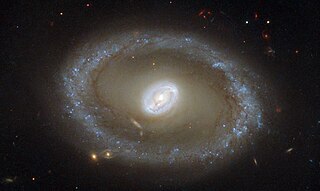
NGC 3081 is a barred lenticular ring galaxy in the constellation of Hydra. NGC 3081 is located about 85 million light-years away from Earth, which means, given its apparent dimensions, that NGC 3081 is approximately 60,000 light-years across. It is a type II Seyfert galaxy, characterised by its bright nucleus. It was discovered by William Herschel on 21 December 1786.

NGC 7469 is an intermediate spiral galaxy in the constellation of Pegasus. NGC 7469 is located about 200 million light-years away from Earth, which means, given its apparent dimensions, that NGC 7469 is approximately 90,000 light-years across. It was discovered by William Herschel on November 12, 1784.

NGC 7130 is a spiral galaxy located in the constellation Piscis Austrinus. It is located at a distance of about 220 million light years from Earth, which, given its apparent dimensions, means that NGC 7130 is about 100,000 light years across. It was discovered by John Herschel on September 25, 1834, and discovered independently by Lewis Swift on September 17, 1897. The location of the galaxy given in the New General Catalogue was off by 30 arcminutes in declination from the location of the galaxy.

NGC 7674 is a spiral galaxy located in the constellation Pegasus. It is located at a distance of about 350 million light years from Earth, which, given its apparent dimensions, means that NGC 7674 is about 125,000 light years across. It was discovered by John Herschel on August 16, 1830.
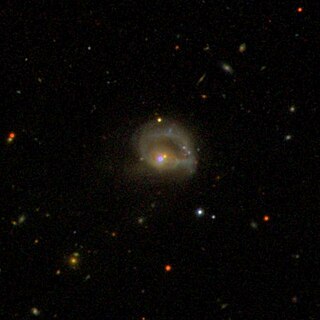
NGC 985 is a ring galaxy in the constellation of Cetus. It is located about 550 million light years away from Earth, which means, given its apparent dimensions, that NGC 985 is approximately 160,000 light years across. It was discovered by Francis Leavenworth in 1886. It is a type 1 Seyfert galaxy.

NGC 6951 is a barred spiral galaxy located in the constellation Cepheus. It is located at a distance of about 75 million light-years from Earth, which, given its apparent dimensions, means that NGC 6951 is about 100,000 light-years across. It was discovered by Jérôme Eugène Coggia in 1877 and independently by Lewis Swift in 1878.

NGC 1386 is a spiral galaxy located in the constellation Eridanus. It is located at a distance of circa 53 million light years from Earth, which, given its apparent dimensions, means that NGC 1386 is about 50,000 light years across. It is a Seyfert galaxy, the only one in Fornax Cluster.

NGC 1142 is a distorted spiral galaxy in the constellation of Cetus. It is located about 370 million light years away from Earth, which means, given its apparent dimensions, that NGC 1142 is approximately 170,000 light years across. It is a type 2 Seyfert galaxy. It interacts with the elliptical galaxy NGC 1141.
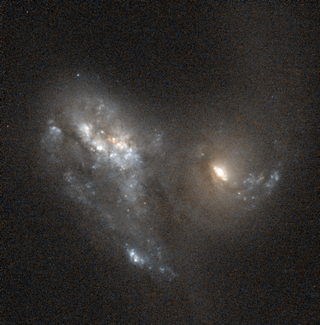
NGC 7592 is an interacting galaxy system located 300 million light years away in the constellation Aquarius. It was discovered by William Herschel on September 20, 1784. The total infrared luminosity is 1011.33 L☉, and thus it is categorised as a luminous infrared galaxy. One of the galaxies hosts a type 2 Seyfert nucleus.



















